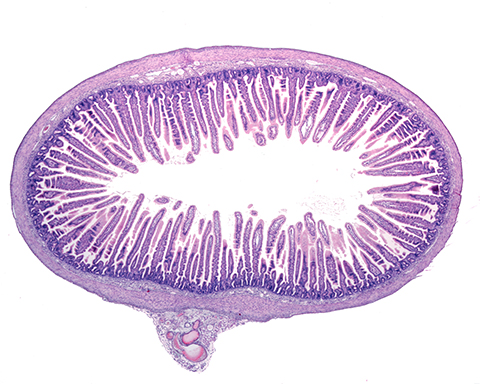From the journals: JLR
Lipid flux in the small intestine. New treatment for a lipid imbalance. Read about articles on these topics recently published in the Journal of Lipid Research.
Let me in! Lipid flux in the small intestine
The mammalian digestive tract consists of five distinct compartments that collectively absorb nutrients, water and electrolytes, and excrete waste products. The small intestine is where food-derived amino acids, carbohydrates and lipids are transported from the intestinal lumen to the lymph and blood so they ultimately can reach the adipose tissue, heart and muscles for storage or energy production. The functional unit of the intestine is the enterocyte, a cell with two structurally and functionally different membrane regions: the apical domain facing the lumen and the basolateral domain interacting with the neighboring cells and with the lymphatic and blood vessels.

Past research has focused on the unidirectional path for dietary lipids from intestinal lumen to lymph via the enterocyte’s apical brush border membrane. This apical track supplies triglycerides, cholesterol and phospholipids to the general circulation for uptake by peripheral tissues, while a small fraction remain inside the enterocyte. In a recent review published in the Journal of Lipid Research, Joshua R. Cook and colleagues from Columbia University and the University of Pittsburgh describe details of intestinal lipid flux and highlight the dual track model via the basolateral membrane.
As the authors explain, scientific evidence dating to the 1950s suggests the basolateral track supplies the enterocyte with a second type of lipid reserves derived mainly from uptake of circulating free fatty acids and triglycerides and from newly synthesized lipids from circulating carbohydrates. Researchers know less about the fate and physiological relevance of these basolateral track lipids. The authors present evidence suggesting that intestinal fatty acids could undergo oxidation for energy production during fasting, could be fluxed to adjacent cells or could be used during synthesis of complex lipids.
Cook and colleagues also explore the crosstalk between the apical and basolateral tracks in the context of metabolism regulation. The authors hypothesize that these tracks work synergistically as an energy-sensing circuit, with the apical as what they call a “systemic fat output” and the basolateral track as a conduit for “systemic fat return” depending on whole-body energy status and needs.
Further research is needed to understand the implications of this integrated response in metabolic diseases such as obesity and diabetes.
New treatment for a lipid imbalance
The abnormal imbalance of plasma lipids, or dyslipidemia, is a well-known risk factor for cardiovascular diseases. One such imbalance is an increase of circulating triglycerides, or TG, called hypertriglyceridemia, which affects between 14% and 38% of the world’s population. Treatments include changes in diet and lifestyle or drugs such as statins and fibrates.
Rene Rodriguez–Gutierrez from the Autonomous University of Nuevo León, Mexico, and collaborators from the pharmaceutical industry are exploring other options. They recently conducted a clinical trial comparing the efficacy and safety of the drugs saroglitazar and fenofibrate in patients with severe dyslipidemia, and their findings were published in the Journal of Lipid Research. Both drugs act on the peroxisome proliferator-activated receptors, or PPARs, a group of proteins in the cellular nucleus that act as energy sensors, influencing lipid and glucose metabolism. While fenofibrate is a well-established PPAR alpha agonist for the management of dyslipidemias, saroglitazar is a recently developed PPAR alpha and gamma dual agonist. Saroglitazar has been effective in lowering triglyceride levels and increasing insulin sensitivity in patients with moderate lipid imbalance, but researchers had not yet evaluatred its use on severe dyslipidemia.
Rodriguez–Gutierrez and colleagues treated 41 patients with moderate to severe hypertriglyceridemia with either saroglitazar or fenofibrate for 12 weeks and calculated the percent change in TG levels compared to baseline. They found that the dual PPARα and γ agonist saroglitazar induced a 55.3% mean reduction in TG levels compared to the 41.1% achieved by the PPARα agonist fenofibrate. Furthermore, 24% of the patients treated with saroglitazar had normal TG levels at the end of the 12 weeks compared to 12.2% of those receiving fenofibrate. Also, diabetic patients receiving saroglitazar showed a significant reduction in fasting insulin and C-peptide, suggesting additional benefits for insulin sensitivity. None of the patients reported serious adverse effects during the treatment.
The authors concluded that a 12-week course of saroglitazar was not inferior to fenofibrate in lowering TG levels in moderate to severe hypertriglyceridemia. Furthermore, they reported other benefits of saroglitazar over fenofibrate such as lesser indication of liver and kidney damage. Future studies could expand on the unique effects of dual PPARα and γ activation as treatment for lipid imbalance.
Enjoy reading ASBMB Today?
Become a member to receive the print edition four times a year and the digital edition monthly.
Learn moreGet the latest from ASBMB Today
Enter your email address, and we’ll send you a weekly email with recent articles, interviews and more.
Latest in Science
Science highlights or most popular articles

Fueling healthier aging, connecting metabolism stress and time
Biochemist Melanie McReynolds investigates how metabolism and stress shape the aging process. Her research on NAD+, a molecule central to cellular energy, reveals how maintaining its balance could promote healthier, longer lives.

Mapping proteins, one side chain at a time
Roland Dunbrack Jr. will receive the ASBMB DeLano Award for Computational Biosciences at the ASBMB Annual Meeting, March 7–10, just outside of Washington, D.C.

Exploring the link between lipids and longevity
Meng Wang will present her work on metabolism and aging at the ASBMB Annual Meeting, March 7-10, just outside of Washington, D.C.

Defining a ‘crucial gatekeeper’ of lipid metabolism
George Carman receives the Herbert Tabor Research Award at the ASBMB Annual Meeting, March 7–10, just outside of Washington, D.C.

The science of staying strong
Muscles power every movement, but they also tell the story of aging itself. Scientists are uncovering how strength fades, why some species resist it and what lifestyle and molecular clues could help preserve muscle health for life.

Bacteriophage protein could make queso fresco safer
Researchers characterized the structure and function of PlyP100, a bacteriophage protein that shows promise as a food-safe antimicrobial for preventing Listeria monocytogenes growth in fresh cheeses.

